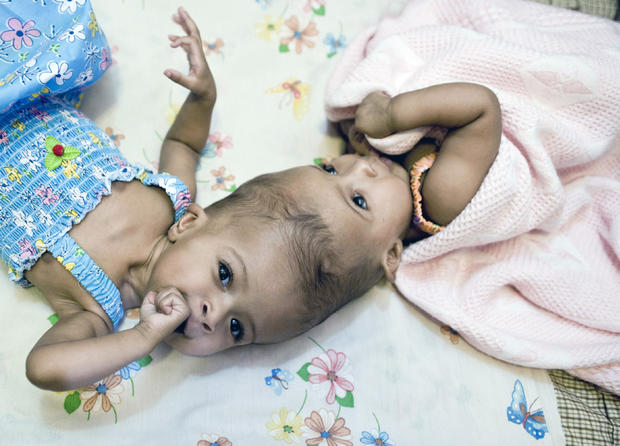Conjoined twins connected at head separated in London
(CBS/AP) Conjoined twins born connected head-to-head were successfully separated in a series of operations at a London children's hospital, officials said Sunday.
PICTURES - Conjoined twins: 34 amazing photos (GRAPHIC IMAGES)
Rital and Ritag Gaboura, 11-month-olds from Sudan, were separated in a risky, four-stage operation, according to Facing the World, a charity that helps disfigured children. The charity said it had helped fund the surgery.
Twins born joined at the head, known as craniopagus twins, occur in about one in 2.5 million births. Separating them can be dangerous, especially if - as in this case - there's significant blood flow between their brains. "It's extremely high-risk," said Dr. James Goodrich, who coordinated a similar separation of conjoined twins at New York's Montefiore Children's Hospital in 2004.
But the alternative can be just as bad. Because conjoined twins almost never pump the blood across their bodies evenly, the stronger sibling strains his/her heart trying to pick up the slack. Facing the World said Ritag's overworked heart was already failing by the time her family arrived in Britain.
The charity said that the separation took place in stages at London's Great Ormond Street Hospital. Two operations took place in May. Tissue expanders - essentially balloons intended to help stretch the babies' skin over their heads - were inserted in July. The final separation took place on Aug. 15.
"Incidences of surviving twins with this condition is extremely rare," lead surgeon David Dunaway said in a statement released by the charity. "The task presented innumerable challenges and we were all very aware of our responsibilities to the family and these two little girls."
Though rare, operations to separate twins linked by their heads aren't unheard of. The U.S. National Library of Medicine records that one of the first successful operations to separate craniopagus twins took place in 1956.
In 2003, surgeons in Dallas separated 2-year-old Egyptian twins joined at the head, and a year later Goodrich was one of a team of doctors who separated Filipino twins in four major surgeries that took place over 10 months.
Even successful operations can leave neurological damage, although that didn't immediately appear to be the case with Rital and Ritag.
"Within days the twins were back on the general ward interacting and playing as before," the charity said. Its executive coordinator, Sarah Driver-Jowitt, predicted that the girls' parents - who haven't been named - may soon return home "with two healthy, separate girls."
Goodrich agreed.
"So far the results have been exceptional," he said. "I think both kids will do quite well."
The Seattle Children's Hospital has more on conjoined twins.

